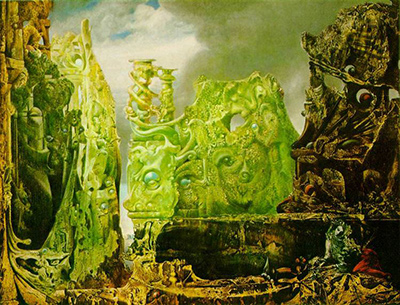In this painting from around 1943–44, Max Ernst creates an environment which feels suitable to a Science Fiction film. In order to appreciate the textures and details across the contours of this imaginary world, the original painting can normally be found at the Mildred Lane Kemper Art Museum in St. Louis, Missouri, US.
Ernst would look deep into his mind in order to find inspiration for a number of his Surrealist paintings. Dreams were a key element of this, as were some of his stronger emotions such as fear and love. The result of this would be combinations of items that one would never consciously put together, creating surreal compositions. Sigmund Freud's writings were a key element behind this, and this was new for an artist to take this scientist's findings as inspiration for whole series of artistic works. A close examination of The Eye of Silence will uncover elements of vegetation, stone and rock. Curiously, some of the formations of rock also resemble every day items, but why? One can assume this was symbolism at work and not pure coincidence. As we know, every element of an Ernst painting was always given careful thought before being added, even though we aren't always sure why is was put in.
The artist makes use of a fairly standard sky to fill the upper quarter of the painting, but everything else feels pure fantasy. Jewels can be seen embedded into parts of the rock faces, and there are also what look like facial features disguised within other parts of the scene. The appears to be a small pool in the foreground, around which the stoned walls are placed. There appears to be a small female figure in the bottom right hand corner. By this point in his career, Max Ernst had developed a significant number of tools and techniques within his career, almost like a Surrealist toolset from which he could draw all manner of ideas to complete each of his works. His paintings were becoming bolder and more detailed, when earlier pieces were only concerned about symbolism rather than providing aesthetic value too.




